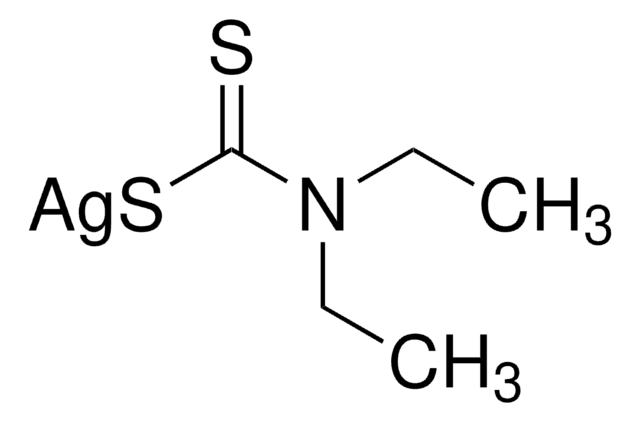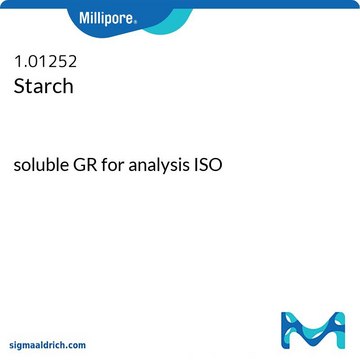1.01515
Silver diethyldithiocarbamate
for analysis EMSURE®,Reag. Ph Eur
Sinónimos:
Silver diethyldithiocarbamate, Diethyldithiocarbamic acid silver salt
About This Item
Productos recomendados
Agency
reag. Ph. Eur.
Nivel de calidad
Línea del producto
EMSURE®
Ensayo
≥99 % ((DSC (differential scanning calorimetry)))
Formulario
solid
pH
5.0-6.5 ( in H2O, suspension)
mp
178-183 °C
densidad aparente
340 kg/m3
temp. de almacenamiento
2-8°C
cadena SMILES
CCN(CC)C(=S)[S-].[Ag+]
InChI
1S/C5H11NS2.Ag/c1-3-6(4-2)5(7)8;/h3-4H2,1-2H3,(H,7,8);/q;+1/p-1
Clave InChI
NSVHDIYWJVLAGH-UHFFFAOYSA-M
Categorías relacionadas
Aplicación
- Arsenite tolerance and removal potential of the indigenous halophilic bacterium, Halomonas elongata SEK2.: This study explores the application of silver diethyldithiocarbamate in bioremediation, specifically its role in enhancing arsenite removal by Halomonas elongata SEK2. This research provides insights into the potential of using complexed silver compounds in environmental cleanup efforts, particularly in saline environments where traditional methods may fail. The findings could significantly impact wastewater treatment and environmental sustainability practices (Tavoosi et al., 2024).
- The development and use of an innovative laboratory method for measuring arsenic in drinking water from western Bangladesh.: This paper details the use of silver diethyldithiocarbamate in a novel analytical method to measure trace levels of arsenic in drinking water. This development not only enhances the accuracy and sensitivity of arsenic detection but also demonstrates the critical role of silver diethyldithiocarbamate in public health monitoring, offering a significant improvement over traditional testing methods (Frisbie et al., 2005).
- Methods of analysis for toxic elements in food products. 2. Review of USSR standards on determinations of heavy metals and arsenic.: This review discusses various methods, including the use of silver diethyldithiocarbamate, for the analysis of toxic elements in food products. The article highlights the importance of stringent quality control in food safety and the role of advanced chemical reagents in ensuring the reliability of detection methods in the food industry (Skurikhin, 1989).
Nota de análisis
Identity (IR-spectrum): passes test
Appearance of solution (in pyridine): passes test
pH-value (aqueous suspension): 5.0 - 6.5
Melting range (DSC (differential scanning calorimetry)): 178 - 183 °C
Spec. Absorptivity A 1%/1cm (of the As-complex; 525 nm; 0.00033 %; 1 cm; pyridine): ≥ 1500
Nitrate (NO₃): ≤ 0.01 %
Loss on Drying (105 °C): ≤ 0.5 %
Sensitivity (for determination of arsenic): passes test
Información legal
Código de clase de almacenamiento
11 - Combustible Solids
Clase de riesgo para el agua (WGK)
WGK 3
Punto de inflamabilidad (°F)
Not applicable
Punto de inflamabilidad (°C)
Not applicable
Certificados de análisis (COA)
Busque Certificados de análisis (COA) introduciendo el número de lote del producto. Los números de lote se encuentran en la etiqueta del producto después de las palabras «Lot» o «Batch»
¿Ya tiene este producto?
Encuentre la documentación para los productos que ha comprado recientemente en la Biblioteca de documentos.
Los clientes también vieron
Nuestro equipo de científicos tiene experiencia en todas las áreas de investigación: Ciencias de la vida, Ciencia de los materiales, Síntesis química, Cromatografía, Analítica y muchas otras.
Póngase en contacto con el Servicio técnico






